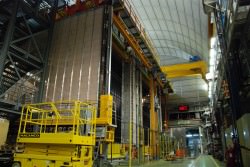[/caption]
New test results are in from OPERA and it seems those darn neutrinos, they just can’t keep their speed down… to within the speed of light, that is!
A report released in September by scientists working on the OPERA project (Oscillation Project with Emulsion-tracking Apparatus) at Italy’s Gran Sasso research lab claimed that neutrinos emitted from CERN 500 miles away in Geneva arrived at their detectors 60 nanoseconds earlier than expected, thus traveling faster than light. This caused no small amount of contention in the scientific community and made news headlines worldwide – and rightfully so, as it basically slaps one of the main tenets of modern physics across the face.
Of course the scientists at OPERA were well aware of this, and didn’t make such a proclamation lightly; over two years of repeated research was undergone to make sure that the numbers were accurate… as well as could be determined, at least. And they were more than open to having their tests replicated and the results reviewed by their peers. In all regards their methods were scientific yet skepticism was widespread… even within OPERA’s own ranks.
One of the concerns that arose regarding the discovery was in regards to the length of the neutrino beam itself, emitted from CERN and received by special detector plates at Gran Sasso. Researchers couldn’t say for sure that any neutrinos detected were closer to the beginning of the beam versus the end, a disparity (on a neutrino-sized scale anyway) of 10.5 microseconds… that’s 10.5 millionths of a second! And so in October, OPERA requested that proton pulses be resent – this time lasting only 3 nanoseconds each.

The results were the same. The neutrinos arrived at Gran Sasso 60 nanoseconds earlier than anticipated: faster than light.
The test was repeated – by different teams, no less – and so far 20 such events have been recorded. Each time, the same.
Faster. Than light.
What does this mean? Do we start tearing pages out of physics textbooks? Should we draw up plans for those neutrino-powered warp engines? Does Einstein’s theory of relativity become a quaint memento of what we used to believe?
Hardly. Or, at least, not anytime soon.
OPERA’s latest tests have managed to allay one uncertainty regarding the results, but plenty more remain. One in particular is the use of GPS to align the clocks at the beginning and end of the neutrino beam. Since the same clock alignment system was used in all the experiments, it stands that there may be some as-of-yet unknown factor concerning the GPS – especially since it hasn’t been extensively used in the field of high-energy particle physics.
In addition, some scientists would like to see more results using other parts of the neutrino detector array.
Of course, like any good science, replication of results is a key factor for peer acceptance. And thus Fermilab in Batavia, Illinois will attempt to perform the same experiment with its MINOS (Main Injector Neutrino Oscillation Search) facility, using a precision matching OPERA’s.
MINOS hopes to have its independent results as early as next year.
No tearing up any textbooks just yet…
Read more in the Nature.com news article by Eugenie Samuel Reich. The new result was released on the arXiv preprint server on November 17. (The original September 2011 OPERA team paper can be found here.)

